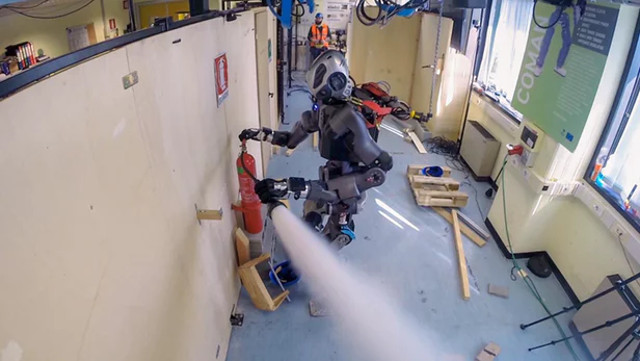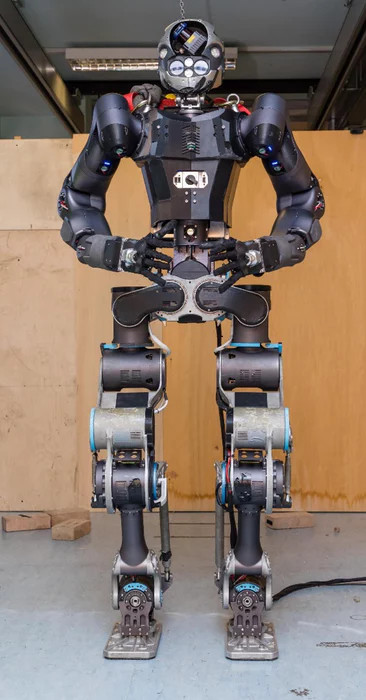New firefighting robots are put into testing
Researchers at Italy's IIT-Istituto Italiano di Tecnologia have succeeded in testing a new version and improving the WALK-MAN humanoid robot, designed to assist firefighters.
WALK-MAN has been developed through a European-funded project, including the University of Pisa in Italy, the École Polytechnique Fédérale de Lausanne (EPFL) in Switzerland, the Karlsruhe Institute of Technology in Germany, and Université Catholique de Louvain in Belgium. The project started in 2013, with the original version of the robot completed in 2015.

Remote controlled by a controller wearing a sensor, WALK-MAN will move into a building, find the fire, extinguish it with a fire extinguisher. The robot head incorporates a laser scanner and a 3D microphone and video cameras directly to the operator.
Thirty-two motors and control panels are used to control the robot body, along with four load cells and moments located in the hands and feet, and two accelerometers that allow it to balance when moving. as well as on duty.

The new version of WALK-MAN has a height of 1.85m, and weighs 102kg, 31kg lighter than the original robot version. Most light parts are located in the upper body of the robot, made of magnesium alloy and composite material.
Because it's lighter, it can move legs faster. This allows it to react faster to maintain center balance, and not fall over uneven terrain. And because it is more compact, it easily passes through narrow paths.
It can operate for about two hours with one battery charge.
Another improvement is the hand, the artificial fingers are more like human hands - this means it can capture better. In addition, thanks to a new version of the light actuator used in hand, it can now lift 10kg for each arm, more than the original 7kg.
In the recent test, the robot succeeded in opening a door to enter the room, locating and closing a valve to prevent false gas leakage, removing debris blocking its path, then finding Fire and use a fire extinguisher.
Video about fire fighting robots:
See more:
- Intelligent robot implants to treat rare birth defects in the esophagus
- Robot milliDelta robot is set up with roles in production and medicine
- Robots are equipped with two arms to help harvest cucumbers
You should read it
- 10 robots have succeeded in proving they are new generation animals
- Watch extremely fierce and fierce sumo fighting robots
- The world's most complicated maid robot dog will be released later this year
- Sophia - What is the world's first civilian robot in Saudi Arabia?
- Admire Anymal robots that can use elevators like people
- Amazon uses robots that are 5 times more productive than humans in warehouses
- Russian new robots can shoot themselves with two hands like humans
- Small autonomous robots can think and act like insects
May be interested
- Self-sustaining plastic can create more environmentally friendly wind turbines
 a vanderbilt group led by professor doug adams is testing a new thermoplastic called elium.
a vanderbilt group led by professor doug adams is testing a new thermoplastic called elium. - AutoSaw experiment system, using robots to serve sawing
 scientists at mit's computer and intelligence science laboratory (csail) have developed an experimental system called autosaw, which uses robots to serve woodworking.
scientists at mit's computer and intelligence science laboratory (csail) have developed an experimental system called autosaw, which uses robots to serve woodworking. - Nanowood white materials promise special insulation
 engineers at the university of maryland created a new insulating material capable of preventing temperatures higher than 100 degrees celsius compared to porous or air silica.
engineers at the university of maryland created a new insulating material capable of preventing temperatures higher than 100 degrees celsius compared to porous or air silica. - New 3D printing techniques especially for stainless steel materials
 the international team of researchers has developed a new 3d printing technique for stainless steel materials with exceptional durability and ductility.
the international team of researchers has developed a new 3d printing technique for stainless steel materials with exceptional durability and ductility. - New molecular printing technology can reproduce a complex chemical environment similar to the human body
 new model technology can open up the opportunity to re-create complex biological environments developed by researchers at queen mary university in london (qmul).
new model technology can open up the opportunity to re-create complex biological environments developed by researchers at queen mary university in london (qmul). - A new form of 'excitonium' is discovered.
 scientists have demonstrated the existence of a new type of material called the excitonium - first hypothesized nearly 50 years ago.
scientists have demonstrated the existence of a new type of material called the excitonium - first hypothesized nearly 50 years ago.






 Attack of security robots, a man is 'wanted'
Attack of security robots, a man is 'wanted' Admire Uniqlo's ultra-modern robot, which can fold clothes and pack standard products like a human
Admire Uniqlo's ultra-modern robot, which can fold clothes and pack standard products like a human Robots are also 'fired' before the technology industry's cost-cutting efforts
Robots are also 'fired' before the technology industry's cost-cutting efforts Admire Anymal robots that can use elevators like people
Admire Anymal robots that can use elevators like people Can people and robots give birth together in 100 years?
Can people and robots give birth together in 100 years?